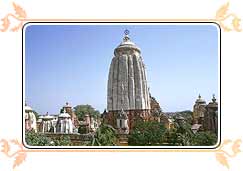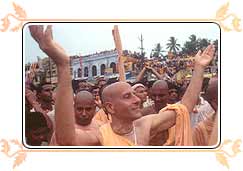| Location:
|
60-km from
Bhubaneswar, Orissa |
| Reigning
Deity: |
Lord
Jagannatha |
| Main
Attractions: |
Lord
Jagannatha Temple, Puri Beach & Gundicha Mandir |
| Significance:
|
One of the
four holiest points of pilgrimage for Hindus |
| Related
Links: |
Jagannath
Temple, Puri
Rath Yatra |
Puri Tourism : Puri is the holiest place in Orissa and one of the
biggest pilgrimage centres in India situated on the shoreline of the Bay of
Bengal. Here, the city's activities generally revolve around the Jagannath
Temple where devotees visit from far and near. The town is divided into two
- the old town the main residential area, including the main shops and huge
market area. Most nights, the beaches host colorful markets and the city is
abuzz with life.

Puri
is washed by the sea, and embraced by causarina - fringed beaches. It is
said that one obtains 'moksha' from the cycle of birth and rebirth, if one
stays here for three days and nights. Puri is the hallowed seat of Lord
Jagannath (Lord of the Universe), Subhadra and Balabhadra. One of the four
holy dhams of Hinduism, Puri is possibly one of the very few religious sites
which combines the outdoor pleasures of sea and divine beaches with the
religious sentiments of 'darshan'.
A place, known by many names over the centuries - Nilgiri, Niladri,
Nilachal, Purushottam, Sankhakshetra, Srikshetra, Jagannath Dham, Jagannath
Puri - Puri is dominated by two great forces, one created by God, and the
other by man.
Location
Puri Orissa has the Bay of Bengal and the rice-growing alluvial plain on its east,
Khurda district on its west, Sambalpur on its south and the state capital
Bhubaneshwar on its northern side. The forest area lying to the west of Puri
provides bamboo and sal. The district of Puri encompasses most of the Chilka
Lake, Asia's largest freshwater lake. Bhubaneshwar is also located in Puri
district.
History
The holy city of Puri is located 60-km from Bhubaneswar on the coast of the
Bay of Bengal. It is one of the four holy dhamas of India - Puri, Dwarka,
Rameswaram and Badrinath Sri Ramanuja visited Puri between 1107 and 1117
century AD and stayed for some time. Vishnu Swami visited Puri in the second
half of the 12th century and established a 'Matha' near 'Markandeswar' Tank,
called "Vishnuswami Matha". Nimbarka Acharya also made a
pilgrimage to Puri, and Srila Prabhupada visited in January 1977. The
present temple structure was built in the 12th century by the 'Ganga' King
'Choda Ganga Deva', replacing an earlier structure, which probably dated to
the 10th century.
Until recently, almost the entire temple was covered in white plaster, so
much so that European sailors in previous centuries used it as a navigation
point, referring to it as the "White Pagoda"
Rath Yatra
- - The Car Carnival
Orissa is a land of innumerable fairs and festivals celebrated round
the year but the most spectacular of them is the Rath Yatra, hitherto
known as the Car Festival to western world.
- Celebration
The three wooden deities of lord 'Jagannatha', 'Balbhadra' &
'Devi Subhadra' with 'Sudarshan' are brought out of the main temple
and taken to Gundicha temple for a week's visit in three beautifully
decorated chariots.On day of Puri rath Yatra festival Puri recepies are made.
- Specialty
From the many specialties of the festival the most unique one is
that, this is the only occasion to see, even embrace the deities
irrespective of caste, colour and creed outside the Temple.
- Legend
After performing all the necessary prostrations, he carried the
lump of wood to the temple and, following instructions from
'Brahma', called the court carpenter 'Vishvakarma' to carve out the
image. Vishvakarma agreed to perform the task on condition that no
one so much as set eyes on the deity until it was completed. The
king, however, unable to contain his excitement, peeped through a
crack in the door of the carpenter's workshop during the night to
see how the job was progressing. Vishvakarma spotted him, downed
tools just as he had promised and cast a spell on the deity so that
no one else could finish it.
- Sequence in the Rath Yatra
Divine Procession (Pahandi Bije): The deities are brought out of
the temple to the chariots by rhythmic movement called "Pahandi"
in a royal procession to the accompaniment of the beat of the
'cymbals' and drums and chanting of prayers by devotees.
Sweeping of the Chariots (Chhera Pahanra): After the deities are
installed on their respective Chariots, the traditional King of Puri
sweeps the Chariots with a golden broom, which is known as "Chhera
Pahanra".
Pulling of Chariots (Rath Tana): The most exciting part of the Rath
Yatra is the pulling of Chariots by thousands of devotees to the
Gundicha Temple, which is about 3-kms away from the starting point
of the 'yatra'. Devotees stay in the temple for a week.
Return Journey (Bahuda Yatra): On 'Ashadha Sukla Dasami', the 10th
day of the bright fortnight of Ashadha (June-July), return journey
or 'Bahuda Yatra' of the deities commences in the same manner from
Gundicha temple to the main temple like Rath Yatra.
Suna Besha: Before going in their original abode, the deities are
dressed in Golden attire on the Chariots the next day.
- Nabakalebar
When two months of Ashadha fall in one year, Rath Yatra is observed
as the festival of 'Nabakalebar' the old deities are buried within
the temple premises ('Koilibaikuntha') and are replaced by new
deities, carved out of Margosa trees for which there are set
procedures. Double Ashadha occurs at intervals of 8 to 19 years. As
history records, Nabakalebar was held in 1996, 1977, 1969, 1950 and
1931 during this century.
 Puri
is washed by the sea, and embraced by causarina - fringed beaches. It is
said that one obtains 'moksha' from the cycle of birth and rebirth, if one
stays here for three days and nights. Puri is the hallowed seat of Lord
Jagannath (Lord of the Universe), Subhadra and Balabhadra. One of the four
holy dhams of Hinduism, Puri is possibly one of the very few religious sites
which combines the outdoor pleasures of sea and divine beaches with the
religious sentiments of 'darshan'.
Puri
is washed by the sea, and embraced by causarina - fringed beaches. It is
said that one obtains 'moksha' from the cycle of birth and rebirth, if one
stays here for three days and nights. Puri is the hallowed seat of Lord
Jagannath (Lord of the Universe), Subhadra and Balabhadra. One of the four
holy dhams of Hinduism, Puri is possibly one of the very few religious sites
which combines the outdoor pleasures of sea and divine beaches with the
religious sentiments of 'darshan'.  Symbolically,
the Rath Yatra (chariot festival) is a journey to light from the
dark and begins on the second day of the bright fortnight in the
month of Asad (June-July). It commemorates the journey of Krishna
from Gokul to Mtahura. This festival is celebrated at Puri with
great pomp and ceremony. In this religious journey, Jagannath,
Subhadra and Balbhadra are taken out in procession in three raths
(chariots). The main rath is 43 ft high, 33 ft wide and has 16
wheels. The ropes of the chariots are pulled by millions of
devotees.
Symbolically,
the Rath Yatra (chariot festival) is a journey to light from the
dark and begins on the second day of the bright fortnight in the
month of Asad (June-July). It commemorates the journey of Krishna
from Gokul to Mtahura. This festival is celebrated at Puri with
great pomp and ceremony. In this religious journey, Jagannath,
Subhadra and Balbhadra are taken out in procession in three raths
(chariots). The main rath is 43 ft high, 33 ft wide and has 16
wheels. The ropes of the chariots are pulled by millions of
devotees.